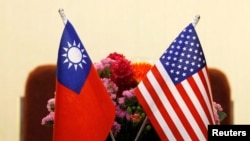The State Department has issued new guidelines for U.S. government interactions with its Taiwanese counterparts to encourage closer contacts and deepen the unofficial relationship between the two democracies, amid increasing Chinese aggression in the region.
"The guidance underscores Taiwan is a vibrant democracy and an important security and economic partner that is also a force for good in the international community," said State Department spokesperson Ned Price in a Friday statement.
The statement spoke only in general terms about the guidelines, which were circulated among government departments but not released to the public.
Taiwan hailed the announcement.
“We welcome the encouragement. Look forward to using new opportunities to work together to deepen the relationship,” said Taiwan’s envoy to the U.S., Bi-khim Hsiao in a tweet.
There is growing cooperation between the U.S. and Taiwan in areas of global health, economics, and regional security. Last month, Washington and Taipei signed an agreement on coast guard cooperation.
The State Department sees the guidelines as consistent with America’s "one China" policy, maintaining that liberalizing contacts with Taiwan is consistent with the Taiwan Relations Act and other existing policy statements known as the three U.S.-China Joint Communiques and the Six Assurances.
The 1979 U.S.-China Joint Communique switched diplomatic recognition from Taipei to Beijing. Relations between the U.S. and Taiwan have been governed by the Taiwan Relations Act passed by Congress in April 1979, under which the U.S. provides defense equipment to Taiwan.
The U.S. had said its long-held “One China” policy is "distinct" from Beijing’s “One China” principle. The U.S. has never endorsed the Chinese Communist Party’s claim of sovereignty over Taiwan.
The new guidelines come as the U.S. Congress introduces major legislation to counter China’s expanding global influence. The proposed bipartisan “Strategic Competition Act of 2021” holds that there should be no restrictions on U.S. officials’ interactions with their Taiwanese counterparts.








